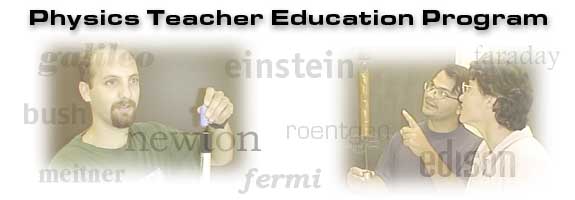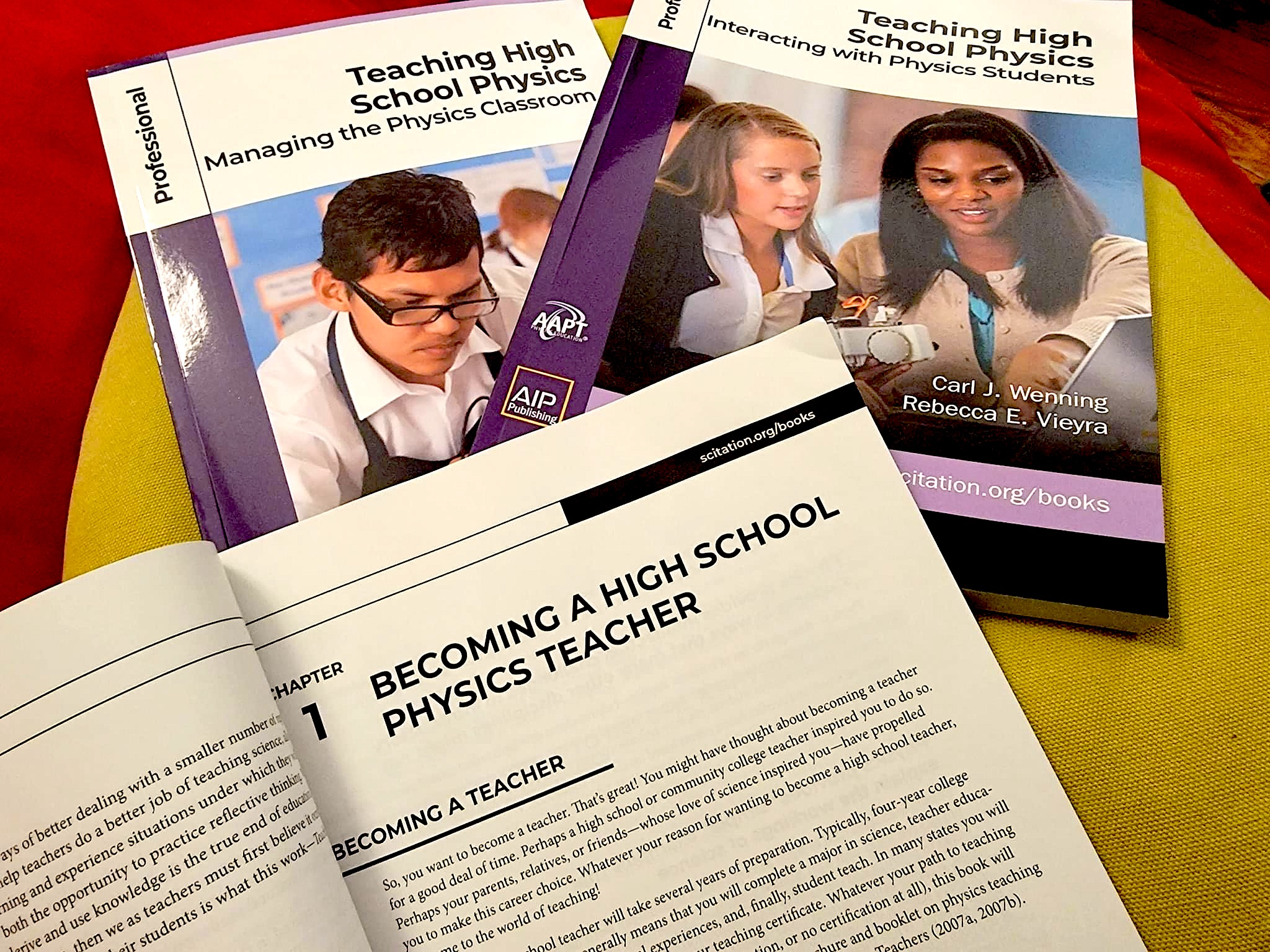

DEPARTMENT OF PHYSICS
(Subject to revision; last updated October 23, 2021)
| COMPUTER APPLICATIONS IN HIGH SCHOOL PHYSICS | 1 s.h. (Lab Course) | Autumn |
1 hr of PHY 270 req.
Applications of electronic technologies in the teaching of high school physics.
Name: Dr. Carl J. Wenning, Physics Teaching Specialist (semi-retired)
ISU Physics Teacher Education Program (Director 1994-2008)
Office Location: TBD
Office Hours: Thursdays 1:00-3:30 PM or by appointment using Zoom (I'm usually setting up for class during this time, so check in 307B or the Physics Storeroom on 2nd floor if you wish to see me without an appointment.)
Mobile Phone: (309) 830-4085 (cell) (I rarely answer, so be certain to leave a message.)
E-mail address: carlwenning@gmail.com (Avoid using cjwennin@ilstu.edu if you want a quick response.)
We meet on Thursdays from 4:40
to 7:30 PM beginning August 19th in
Moulton Hall, room 307-B. There will be no formal breaks as you may come and go as you please during open lab work. On certain occasions, we will meet online using Zoom. These classes will be announced in advance. NB. The first class meeting of 2021 will be held on August 19th using Zoom. Join class just before 4:40 PM using the following link. Subsequent online class meetings (if any) will use this same link.
https://illinoisstate.zoom.us/j/92203629246?pwd=anA0eTVDT3g2RFY2bmtSVGVnQ0xqUT09
The focus in this course is on the use of the laboratory experience as a pedagogical tool for demonstrating the nature of science and the processes of physics. Teacher candidates will encounter the computer and other electronic devices as adjuncts in both class and lab settings. In this course students become familiar with a variety of commonly used computer-based, calculator-based, and cell-phone-based applications for teaching high school physics. The course starts with introductions to hardware and software, and concludes with capstone and research symposium projects that allow students to demonstrate that they understand the experimental nature of science. PHY 302 is not solely a textbook-based course; it makes extensive use of web-based resources. Project guidelines, examples, scoring rubrics, and other resources will be found hyperlinked to this course syllabus.
Many sessions will commence with the instructor providing an orientation to hardware or computer applications. It is therefore imperative that students arrive on time for lab for orientations and be prepared to begin work at the start of the period. Following these orientations, students will complete associated projects separately or working in small groups. Students are permitted to work together to accomplish the various tasks in this course (with the sole exceptions of the capstone and symposium experiences). Each student must turn in his or her own unique reports and/or projects. Reports with multiple names on the sheet are not acceptable, and neither are separate identical reports.
REVISED: In this course emphasis will be placed on an Assessment-for-Learning Policy. That is, assessments of student performance will be used not only to assign scores, but to improve student performance. Unsatisfactory work will be returned to the student for improvement. A student's score can be improved by appropriate revision and resubmission so long as all deadlines are met. This policy does NOT apply to quizzes, tests, and the capstone experience.
PROCEDURE: Students will submit homework in class on the due date. (Late submissions incur an automatic 50% penalty that will not be removed.) The instructor will score, provide comments for improvement, and return assignments with temporary scores at the next class. Students will have until the following class to submit revisions. The original document must be included along with any submitted revisions. Temporary scores become permanent two weeks after initial due date.
There are multiple and varied assessments in this course. They are presented here in no particular order:
Students must complete a number of small projects (e.g., MS Equation Editor, Tracker, Physics Toolbox, etc.).
Students will take reading quizzes using ReggieNet that assume that teachers candidates have not only read (e.g., Student Lab Handbook, Teaching High School Physics, syllabus-linked PDFs, etc.), but have come to understand the substance of the readings through study. Assigned reading quizzes must be completed before the start of class. Late submissions will not be accepted and score zero. Look for reading quizzes online starting 24 hours prior to the next class (i.e., Wednesday afternoons).
Students must independently design and upload to a publicly accessible Internet server an html-based web page suitable for use during student teaching.
Students must complete a number of Excel-based exercises that deal with the use of descriptive statistics, data analysis, statistical testing, simulations, and graphing.
Students must familiarize themselves with a variety of interactive simulations in Physics and then develop a simulation worksheet following specific requirements.
Students will complete labs and turn in lab reports on a semi-regular basis. To complete these lab reports, students need to familiarize themselves with and use guidelines provided.
Students must convert a standard "cookbook" lab into a high school level guided inquiry lab using provided resources and specific guidelines. Student will have another students implement the lab in class. The writer will then revise the guidelines on the basis of this experience before submitting the assignment.
Students must develop a PowerPoint presentation for use with their Capstone Seminar Presentation (see 302I below). PowerPoint appearance will be judged separated from the presentation. See below.
Students must independently design and conduct a bounded-inquiry capstone experiment and complete detailed written and oral reports (including a PowerPoint presentation). Students will be limited to 10 minutes for the presentation, and this will be followed with up to 5 minutes of questions and answers from the class members and instructor. Presentations will be scored by both peers and the course instructor.
All assignments should be submitted electronically to carlwenning@gmail.com. When assignments are submitted, students should expect to receive feedback quickly. The only way this is possible is if students submit work electronically in original files. Submit projects in MS Word if possible and PDF if not. (Avoid using other versions of word processors.) Students should submit assignments early if they want to take full advantage of the above Assessment-for-Learning Policy.
The course grade will be determined on the percentage of total score points earned according to the following scale:
A > 94% |
87% < B < 94% |
79% < C < 87% |
70% < D < 79% |
F < 70% |
The above grading scale might seem a bit high to the student, but it assumes that students will maximize both learning and accomplishments by taking regular advantage of the instructor's Assessment-for-Learning Policy. Meet with your instructor at any time to see where you stand relative to submitted assignments.
Readings will come primarily from TEACHING HIGH SCHOOL PHYSICS (Carl J. Wenning & Rebecca E. Vieyra, AIP Publishing, Melville, New York, 2020). ISU students, faculty, staff, & retirees as well as alumni and Friends of Milner Library have free online access to these references. The volumes are as follows:
Vol. 1: Teaching High School Physics - The Nature of Physics Teaching Vol. 3: Teaching High School Physics - Managing the Physics Classroom In order to access each of three volumes, do the following:
ORDER COPIES: Black & white copies (color covers) are available to ISU students, faculty, and staff via print-on-demand for $30 per volume. Follow the blue MyBook links found on the above page to order copies. Look for discounts. Print-on-demand delivery time is about one week. Color copies are available for $135 each. N.B. Here are some additional useful titles to which you have free online access through AIP Publishing: Honoring Teachers As Professions: Stories and Pathways for Growth in Your Classroom and Career Teaching About Geometric Optics: Student Edition |
 |
| Thur. |
Activity |
Homework to be completed before next class period |
Comments |
| CL#1 8/19 |
|
|
To be turned in or otherwise completed prior to the start of the next class:
|
| CL#2 08/26 |
|
|
To be turned in or otherwise completed prior to the start of the next class:
|
| CL#3 09/02 |
|
|
To be turned in or otherwise completed prior to the start of the next class:
|
|
CL#4 09/09 |
|
|
To be turned in or otherwise completed prior to the start of the next class:
|
| CL#5 09/16 |
|
|
To be turned in or otherwise completed prior to the start of the next class:
|
CL#6 09/23 |
|
|
To be turned in or otherwise completed prior to the start of the next class:
|
|
CL#7 09/30 |
|
|
To be turned in or otherwise completed prior to the start of the next class:
|
CL#8 10/07 |
|
|
To be turned in or otherwise completed prior to the start of the next class:
|
CL#9 10/14 |
|
|
To be turned in or otherwise completed prior to the start of the next class:
|
CL#11 10/21 |
|
|
To be turned in or otherwise completed prior to the start of the next class:
|
| CL#13 10/28 |
|
|
To be turned in or otherwise completed prior to the start of the next class:
|
| CL#14 11/04 |
|
|
N/A |
CL#15 11/11 |
|
Continue Capstone Project experiment and report writing | N/A |
|
CL#16 11/18 |
|
|
To be turned in before the start of Capstone Project Symposium:
|
11/25 |
THANKSGIVING BREAK WEEK |
||
CL#17 12/02 |
Course Evaluation / Capstone Project Symposium |
||
Please make a habit of regularly backing up your computer work -- e.g. make multiple copies. Missing computer files or crashed hard drives are not legitimate excuses for lost work or missed deadlines. Backup, Backup, Backup! When updating versions of work, avoid overwriting earlier versions. The later version might be flawed in some significant way. When making updated versions, label successive projects Job1, Job2, Job3, Job4, etc. You can throw away the very earliest versions if you run out of memory, but be certain to retain the latest two versions at a bare minimum. Make backups of diskettes or flash memories that you will be carrying around. A little bit of effort at the right time now can save a lot of extra effort later (and even a poor grade). Please back up regularly! There is no excuse for doing otherwise.
Also, consider bringing a flash memory to every lab session for backing up course work. If you don't have one, you might want to purchase one. Alternatively, be prepared to save you files to a remote server or copy onto a 100 Meg ZIP disk or similar. Contact your course instructor for a ZIP disk if you would like to borrow one.
Caution: Keep in mind as you progress toward student teaching that as a student teacher your students will have an interest in finding out about you. This will lead them to Internet searches. Don't put anything on a web page, YouTube, Facebook, MySpace, etc., that you wouldn't want students, parents, teachers or administrators to see.
Disposition Concerns: The College of Education, in an effort to ensure top quality graduates, provides faculty members and interested others with the opportunity to provide input into the teacher preparation process. One of these inputs is in the area of disposition concerns. Education faculty, in particular, are encouraged to bring to attention of CECP any significant problems associated with the following major areas. If three or more filed dispositions concerns have not been resolved, the teacher candidate will be blocked from advancing in Professional Studies.